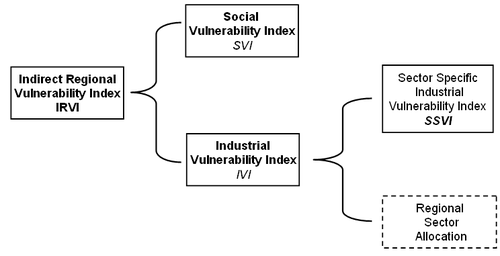Background
The project-spanning working group „ Analysis of Indirect Disaster Vulnerability” (VAG) was founded in May 2008. Its focus is the understanding of indirect losses of disasters and their complex underlying processes at different spatial scales in the context of climate change.
For this purpose, the field of industrial losses of the former CEDIM working group “Asset estimation” is extended towards the vulnerability regarding indirect effects and combined with the assessment of social vulnerabilities within society as further drivers of indirect effects.
The VAG brings together the know-how within CEDIM in the following fields: “Vulnerability of Networks and Critical Infrastructures (projects “Traffic Infrastructure” , “Crisis management for large-area power blackouts”), Indirect business interruption losses (former sub-project of “Megacity Istanbul”) and Social vulnerability and coping capacities of mega-cities (Istanbul Megacity Indicator Systems”).
Objective/Project Tasks
The objective of the VAG consists of the following:
• Developing an integrated indicator model which aims at the analysis of the industrial and social vulnerability against indirect disaster losses on the regional level. Such an indicator framework is useful for addressing the complexity which is inherent in the vulnerability concept as it facilitates the combination of the different sub-systems or dimensions (industrial and social system) and can bring together results at different levels of granularity in an effective manner.
• Developing an indicator model by means of a software tool based on multi-criteria decision analysis (“Logical Decisions for Windows”). The software tool supports sensitivity analysis and visualization of results and facilitates the communication of the results to political or industrial stakeholders.
• Identifying the most vulnerable regions or hotspots of vulnerability, and in particular vulnerable processes and supply decision makers with a multi-facet picture of losses for a foresighted disaster management and the overall reduction of risk.
• The assessment is conducted on the spatial level of NUTS 3 (Landkreise) within the federal state of Baden-Wuerttemberg which as one of the most important economic states of Germany has a high indirect economic loss potential and, therefore, is an ideal pilot area for testing this methodology for indirect loss assessment.

Fig. 1: Overview of the indicator system
Status of the Project
The methodological development of the integrated indicator framework for the assessment of the vulnerability against indirect losses has been finished in July 2011. Based on the availability of statistical data various indicators have been selected to depict the indirect social risk potential as well as the indirect industrial risk potential. The single indicators were combined to one composite indicator using methods from the field of multi-criteria decision analysis (see Fg. 1). Within the assessment of the “Social Risk Index (SVI)” factors influencing the social fragility of a region as well as factors describing it’s coping capacity have been considered. The “Industrial Risk Index” was constructed by combining both fragility and resilience indicators. For the assessment of the industrial disaster risk potential on a spatial level, a new regionalisation method has been developed.
The developed indicator framework has been applied for the assessment of the indirect disaster vulnerability in 44 administrative districts in the federal State Baden-Württemberg (Germany). The development of the methodology, the vulnerability values of the assessed administrative districts and the results of various sensitivity analyses are described in journal paper (Khazai et al., 2011).
Project team
Dr. Bijan Khazai (Geophysical Institute)
Dipl.-Geoök. Mirjam Merz (Institute for Industrial Production)
Dipl.-Wi.-Ing. Carola Schulz (Institute for Economic Policy Research)
Dipl.-Wi.-Ing. Dietmar Borst (Institute for Finance, Banking and Insurance)
Publications
| Khazai, B., Merz, M., Schulz, C., Borst, D. | An indicator framework to compare regional vulnerability in society and industrial sectors. | Natural Hazards (submitted) | ||||
| Hiete, M., Merz, M., Comes, T., Schultmann, F. | Trapezoidal Fuzzy DEMATEL method to analyse and correct for relations between variables in a composite indicator for disaster resilience. | OR Spectrum, (DOI) 10.1007/s00291-011-0269-9 (2011) | ||||
| Merz, M. | Entwicklung einer indikatorenbasierten Methodik zur Vulnerabilitätsanalyse für die Bewertung von Risiken in der industriellen Produktion. | KIT Scientific Publishing, Karlsruhe (in press) | ||||
| Hiete, M., Merz, M. | An Indicator Framework to Assess the Vulnerability of Industrial Sectors against Indirect Disaster Losses. | ISCRAM Conference, 11-13 May 2009, Göteborg (2009) | ||||
| Merz, M., Hiete, M., Schultmann, F. | Entwicklung eines Indikatorenmodells zur Ermittlung der indirekten industriellen Vulnerabilität auf Kreisebene. | Proceedings zum 10. DKKV-Forum Katastrophenvorsorge - Katastrophen – Datenhintergrund und Informationen, 23-24.11.2009, Bonn (2009) |

